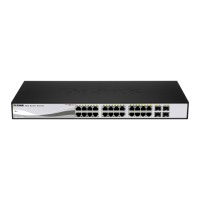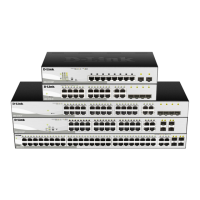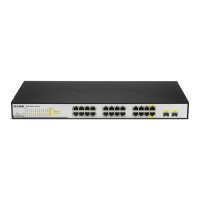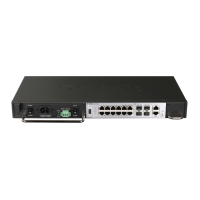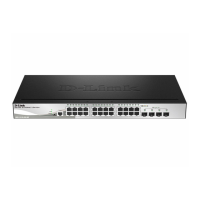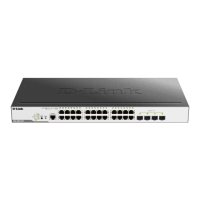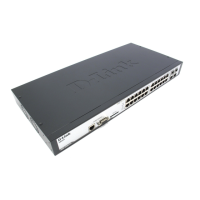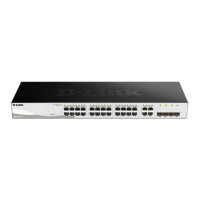
Do you have a question about the D-Link DGS-1210-12TS/ME and is the answer not in the manual?
| Switching Capacity | 24 Gbps |
|---|---|
| Layer | L2 |
| Dimensions | 440 x 180 x 44 mm |
| MAC Address Table Size | 8K |
| Jumbo Frame | Up to 9K bytes |
| Product Type | Managed Switch |
| Humidity | 5% to 95% non-condensing |
| Ports | 12 x 10/100/1000BASE-T |
| Power Supply | 100-240V AC, 50/60 Hz |
| Operating Temperature | 0 to 50 °C |
| Storage Temperature | -40°C to 70°C |
Defines terms used in the manual for clarity and consistency.
Outlines copyright information and acknowledges registered trademarks.
Provides an overview of the DGS-1210/ME Metro Ethernet Switch features and capabilities.
Details the components and indicators on the front panel of the switch for user reference.
Explains the function of each LED indicator on the switch for status monitoring.
Describes the connectors and ports located on the rear panel of the switch.
Covers the side panels, focusing on ventilation and heat dissipation requirements.
Details the SFP ports and their role in fiber-optic connectivity for extended range.
Explains how to connect the Redundant Power Supply (RPS) to the switch for power redundancy.
Guides on installing the RPS into a rack-mount chassis for organized deployment.
Instructions for safely unpacking the DGS-1210/ME Metro Ethernet Switch and checking contents.
Details on installing the switch, including desktop and rack mounting options.
Step-by-step guide for securely connecting the AC power cord to the switch.
Advises on actions to take regarding the switch during power failure events.
Outlines the available methods for managing the switch's configuration.
Introduces using the web interface for switch configuration and monitoring.
Describes how to connect to the switch using the console port for direct management.
Explains the process of accessing the switch's web management interface via IP address.
Introduces the DNA tool for discovering and managing multiple switches efficiently.
Describes the main areas of the web-based management interface: Tool Bar, Function Tree, Main Screen.
Covers functions for saving configurations and logs via the tool bar's save menu.
Introduces global functions accessible from the tool bar menu like reboot and backup.
Explains how to safely reboot the switch system through the tool menu interface.
Details methods for backing up and restoring switch configurations via HTTP, TFTP, or FTP.
Guides on saving and updating the switch's firmware using HTTP or TFTP.
Displays detailed information about the switch's flash memory contents.
Describes how to access online help resources and the D-Link support site for assistance.
Explains how to navigate the function tree for accessing configuration options.
Shows an overview of the switch's firmware, hardware, and IP address status.
Covers configuring basic system information, including IP address and system name.
Displays firmware details and allows specifying configuration and image files for boot-up.
Configures baud rate, auto-logout, and other serial port parameters.
Allows configuration of IPv6 system settings via IP interfaces for network connectivity.
Manages Address Resolution Protocol (ARP) entries for static IP to MAC address translation.
Configures IPv6 system information, including addresses and network settings.
Configures IPv6 neighbor discovery settings for network communication.
Enables automatic DHCP configuration for the switch upon boot-up from a TFTP server.
Allows automatic download and upgrade of firmware images via DHCP for simplified updates.
Monitors and adjusts port speed, duplex, and MDI/MDIX settings for optimal performance.
Allows naming ports for easier identification and management of network connections.
Displays ports with disabled connection status due to errors like STP loopback detection.
Shows the media type information (Copper/Fiber) for each port on the switch.
Enables or disables the global SNMP function on the switch for network management.
Manages SNMPv3 user accounts, defining access levels and security parameters.
Associates users with SNMP groups to control MIB access policy and security.
Defines MIB objects accessible by remote SNMP managers based on views.
Manages SNMP community strings to control network access and data retrieval.
Configures SNMP trap recipients for receiving network event notifications.
Sets the unique Engine ID for SNMPv3 engine identification on the switch.
Configures SNMP trap notifications for various events like link status changes.
Controls user privileges and manages local accounts for switch access and administration.
Specifies the duration MAC addresses remain in the forwarding table before aging out.
Sets the aging time for ARP entries in the switch's ARP table to manage IP-MAC mappings.
Configures settings for inserting circuit tags in PPPoE packets for identification.
Configures the state and port for the web management interface, enabling or disabling access.
Manages the state and port for Telnet access to the switch for command-line management.
Enables or disables password encryption for enhanced security of user credentials.
Performs ping tests to verify network connectivity and troubleshoot communication issues.
Configures monitoring of learned MAC addresses and notification settings for security events.
Configures system logging parameters, including log save modes and intervals.
Sets up Syslog messages to designated remote servers for centralized log management.
Configures time profiles for scheduling device actions and policies based on time.
Reduces power consumption by adjusting port states and LED behavior to conserve energy.
Configures Energy Efficient Ethernet settings to reduce power usage on network links.
Configures SMTP server details for sending email notifications and alerts from the switch.
Sends test emails to verify SMTP configuration and server reliability.
Enables or disables the D-Link Discovery Protocol (DDP) for network device discovery.
Enhances network throughput by enabling support for larger Ethernet frames (Jumbo Frames).
Manages VLANs for network segmentation, improving traffic management and security.
Configures private VLANs for enhanced network security and traffic isolation between ports.
Sets up trunk ports for private VLANs to manage traffic flow and connectivity.
Displays the current VLAN status and configuration details on the switch.
Creates MAC-based VLAN entries to map MAC addresses to specific VLANs for access control.
Configures the GARP VLAN Registration Protocol (GVRP) for dynamic VLAN sharing among switches.
Configures GVRP timer values for application join, leave, and leave_all operations.
Enables or disables the Q-in-Q function for service provider VLAN tagging and encapsulation.
Translates VLAN IDs for packets between private and service provider networks.
Tunnels Layer 2 protocol packets, commonly used with Q-in-Q for network transparency.
Configures untagged ports of different protocols for VLAN grouping.
Configures protocol VLAN settings, mapping protocols to specific VLAN IDs.
Combines multiple VLAN ports to create VLAN trunks for increased bandwidth and link aggregation.
Configures port trunking groups to aggregate bandwidth and enhance link redundancy.
Configures Link Aggregation Control Protocol (LACP) port settings for dynamic link aggregation.
Configures BPDU protection to prevent network loops and mitigate Spanning Tree attacks.
Enables and configures IGMP snooping for intelligent multicast traffic forwarding.
Adjusts global parameters for IGMP snooping behavior like timeouts and query intervals.
Assigns ports as router ports for IGMP snooping within a VLAN for proper multicast operation.
Enables or disables IGMP access control for selected ports to manage multicast traffic.
Configures ISM VLANs to optimize multicast traffic forwarding by reducing copies.
Displays information about IGMP snooping hosts, including VLAN ID and IP address.
Configures IP multicast profiles for managing network multicast traffic flow.
Configures limits for multicast traffic based on port range and IP type (IPv4/IPv6).
Sets the maximum number of multicast groups allowed for IGMP snooping per port.
Manages static group configurations for IGMP snooping, including VLAN and IP addresses.
Configures global parameters for MLD snooping functionality, similar to IGMP snooping.
Displays information regarding MLD snooping hosts, including VLAN ID and IP address.
Sets up port mirroring to monitor network traffic by copying packets for analysis.
Configures loopback detection to identify and prevent network loops by shutting down ports.
Configures Simple Network Time Protocol (SNTP) for time synchronization with network time servers.
Configures time zones and Daylight Saving Time settings for SNTP time synchronization.
Enables and configures global settings for DHCP/BOOTP relay services across the network.
Sets up IP interfaces for relaying DHCP/BOOTP information between clients and servers.
Configures DHCP Local Relay to trap and forward DHCP broadcasts with Option 82.
Configures DHCPv6 relay settings for IPv6 network support and address assignment.
Configures DHCPv6 relay option 38 settings for specific ports and network requirements.
Configures global settings for Spanning Tree Protocol (STP), including version and priority.
Configures Spanning Tree parameters on a per-port basis for loop prevention.
Identifies multiple spanning tree instances (MSTIs) for switch configuration and management.
Displays and modifies MSTP priorities for different spanning tree instances.
Updates port configurations for MSTP instances and selects forwarding interfaces.
Configures Ethernet Operations, Administration, and Maintenance (OAM) settings for ports.
Configures Ethernet OAM event settings and parameters for monitoring network health.
Configures Digital Diagnostic Monitoring (DDM) settings for SFP modules on the switch.
Sets DDM temperature thresholds for ports to monitor SFP module health parameters.
Sets DDM voltage thresholds for ports to monitor SFP module health parameters.
Sets DDM bias current thresholds for ports to monitor SFP module health.
Sets DDM TX power thresholds for ports to monitor SFP module health.
Sets DDM RX power thresholds for ports to monitor SFP module health.
Displays current DDM parameters and values for SFP modules on the switch.
Configures DULD (Unidirectional Link Detection) recover time settings for link status monitoring.
Configures unidirectional link detection status and mode for ports to detect link issues.
Sets up filtering modes for multicast traffic to control its flow.
Configures Ethernet Ring Protection Switching (ERPS) settings for ring network protection.
Controls traffic rates for broadcast, multicast, and unicast packets to prevent storms.
Defines bandwidth settings for port transmit and receive data rates to manage traffic flow.
Selects CoS scheduling mechanism between WRR and Strict Priority for queue management.
Customizes output scheduling for hardware classes of service to optimize traffic handling.
Assigns default 802.1p priority to ports for Quality of Service (QoS) prioritization.
Assigns user priority based on 802.1p tags for QoS traffic management.
Configures priority settings based on DSCP field in IP header for traffic classification.
Configures CoS priority settings on a per-port basis for traffic management.
Enables or disables Remote Monitoring (RMON) status and alarm traps for network monitoring.
Displays and configures RMON Ethernet statistics for network performance analysis.
Manages samples of data taken from ports for history control and trend analysis.
Configures network alarms for detecting problems or events on the switch.
Defines, modifies, and views RMON events statistics for troubleshooting.
Manages remote access stations by defining IP addresses and subnet masks for security.
Enables Safeguard Engine to throttle packet flooding and protect the CPU from attacks.
Configures CPU protection types and rate limits to manage traffic impacting the CPU.
Configures ARP announcements for IP interface status and duplicate IP detection.
Prevents unauthorized access by securing MAC addresses on switch ports.
Configures Secure Sockets Layer (SSL) for secure web management communication.
Restricts client access by enabling pairs of MAC and IP addresses for network security.
Creates static IP-MAC-Port binding entries for enhanced network security and access control.
Displays allowed IP-MAC-Port binding entries for switch access, enhancing security.
Lists unauthorized accesses and forbidden devices to maintain network integrity.
Shows the list of devices participating in DHCP snooping for network security.
Configures IEEE 802.1X for network access control and port authentication.
Sets up local users for 802.1X authentication on the switch for secure access.
Configures RADIUS server settings for centralized user authentication and management.
Configures a guest VLAN for temporary network access under 802.1X authentication.
Configures static MAC addresses to enhance network security by preventing unauthorized access.
Views the switch's dynamic MAC address forwarding table for network traffic analysis.
Enables or disables the auto-learning feature for VLANs, simplifying network configuration.
Sets administrator-defined authentication policies for user access to the switch.
Configures authentication methods for console, Telnet, SSH, and HTTP applications.
Groups TACACS+ and RADIUS servers for centralized authentication management.
Configures TACACS+ and RADIUS authentication server hosts for secure access control.
Configures user-defined or default login methods for switch access and authentication.
Sets up method lists to promote users from user level to administrator privileges.
Configures the locally enabled password for administrator privileges on the switch.
Limits traffic flow from ports to groups for network segmentation and traffic control.
Configures settings to prevent Denial of Service (DoS) attacks on the network by filtering malicious traffic.
Restricts illegal DHCP servers by discarding service from distrusted ports for network security.
Configures VLAN state for DHCP Server Screening to enhance security against rogue DHCP servers.
Designs trusted DHCP server IP and client MAC addresses to allow legitimate DHCP traffic.
Designs trusted DHCPv6 server IP addresses for secure IPv6 network operation.
Designs trusted ICMPv6 server IP addresses for network security and filtering.
Configures Secure Shell (SSH) for secure remote login and network services, protecting against unauthorized access.
Configures SSH authentication modes and algorithms for secure encrypted communication.
Configures parameters for users attempting SSH access, managing authentication lists.
Configures global MAC-based Access Control settings and authentication methods.
Sets lists of MAC addresses and their associated VLANs for local authentication.
Configures the authentication state for ports under MAC-based Access Control for security.
Displays port packet count statistics for monitoring network activity and performance.
Views detailed information on current configuration sessions and user activity for auditing.
Displays CPU usage percentage over time for performance monitoring and issue diagnosis.
Displays memory usage percentage over time for performance analysis and resource management.
Shows the percentage of total bandwidth used on each port for capacity planning.
Analyzes packet sizes by viewing graphs or tables of received packets for traffic profiling.
Displays graphs and tables of transmitted packets per port for performance monitoring.
Displays graphs and tables of received packets per port for network analysis.
Shows graphs and tables of Unicast, Multicast, and Broadcast packets received on ports.
Displays graphs and tables of error packets received on ports for troubleshooting.
Displays graphs and tables of error packets transmitted from ports for performance analysis.
Examines copper cable quality and identifies cable errors to ensure network integrity.
Provides information about system logs, device operations, and user activity for auditing.
Displays IP to MAC address mappings for ARP VLANs for network troubleshooting.
Displays Ethernet OAM event log information for ports to monitor link status.
Displays Ethernet OAM statistics information for ports for network performance analysis.
Displays current IGMP snooping static group information on the switch for multicast management.
Displays information about IGMP snooping hosts for multicast traffic tracking.
Configures MLD Snooping group settings for multicast traffic management.
Shows activity of the RADIUS authentication client and server statistics for access control.
Displays RADIUS accounting client information and associated statistics for auditing.
Configures global settings for the sFlow traffic monitoring system for network visibility.
Configures sFlow analyzer server settings for traffic analysis and collection.
Configures sFlow flow sampler parameters for port traffic sampling and analysis.
Configures sFlow counter poller settings for collecting performance data from network devices.
Guides through creating Access Control List (ACL) profiles and rules for packet filtering.
Manages ACL profiles, associating them with interfaces for defining packet forwarding rules.
Helps find previously configured ACL entries by profile ID or port for management.
Aids in creating CPU Filter rules to manage packet processing and protect switch resources.
Manages CPU Filter profiles and defines packet forwarding rules for CPU protection.
Helps find previously configured CPU filter entries for review and modification.
Configures bandwidth control for ingress traffic using ACL rules for traffic shaping.
Configures Power over Ethernet (PoE) settings for individual switch ports, including power limits.
Displays and configures overall PoE status, budget, and power supply management.
Configures time profiles for enabling PoE functionality based on schedule for power management.
Configures global Link Layer Discovery Protocol (LLDP) parameters for device advertisement and topology learning.
Configures LLDP settings on a per-port basis for neighbor device discovery.
Configures LLDP port settings for 802.1 specific extensions and capabilities.
Configures LLDP port settings for 802.3 specific extensions and capabilities.
Sets management addresses included in LLDP information for network management.
Displays an overview of all LLDP traffic statistics for network monitoring.
Shows detailed management address information for LLDP entries.
Displays LLDP local port information for each port, including details like port ID and description.
Displays basic LLDP local port information for quick reference.
Shows detailed LLDP local port information for in-depth analysis.
Displays LLDP remote port brief table information for neighbor device discovery.
Displays basic LLDP remote port information for neighbor device discovery.
Shows detailed LLDP remote port information for neighbor device discovery.
Configures LLDP-MED settings for power PSE TLV type, enhancing power management.
Creates static route entries for IPv4 formatted addressing for network routing.
Displays all external routes information for the switch's IPv4 routing table.
Enters static route entries for IPv6 formatted addresses for network routing.
Displays all external routes information for the switch's IPv6 routing table.
Describes the features and technology behind Gigabit Ethernet for high-speed networking.
Explains the characteristics and benefits of Fast Ethernet technology for network evolution.
Details the principles and advantages of Ethernet switching technology for network efficiency.
Lists and describes Layer 2 features supported by the switch, such as MAC addressing and snooping.
Details the Virtual LAN (VLAN) capabilities and standards supported for network segmentation.
Lists and describes Layer 3 features, including routing capabilities and IP addressing.
Describes Quality of Service (QoS) features for traffic prioritization and bandwidth management.
Lists Authentication, Authorization, and Accounting (AAA) features for user access control.
Describes Access Control List (ACL) features for packet filtering and security policies.
Lists and describes various security features implemented on the switch for network protection.
Describes Operations, Administration, and Maintenance (OAM) features for network monitoring and management.
Lists and describes the management interfaces and capabilities of the switch for administration.
